Under and Back Again - Pt. VIII
August 2, 2006
Here it is at last: the Final Morning (rather dead-sounding fanfare).
In fact, it is &%$#* 5:30 in the &#%$* morning. That's when the #%$&* wake-up call rings. That's to give us enough time to throw our luggage together, have a nice (%#$&*) early breakfast, haul all our (%$&#*) gear down to the bus, and head off to the last chapter of our Australia adventure.
We have been warned that it is going to be cold. Sydney itself has been a bit on the chilly side, but now we are heading for the BLUE Mountains. At this time of year it's not uncommon for it to get down close to freezing up there. Yes, we have been warned of this fact repeatedly. That's why most of our kids are in light coats and more than one is wearing shorts. (Death before non-fashion, right?)
The drive up to the BLUE Mountains is nice and scenic. The urbanness of Sydney gradually gives way to lovely harbor towns and then becomes something more like those sleepy villages one finds around the Coast Mountains in Oregon. However, the BLUE Mountains are a very different animal from that. For one thing, they aren't really mountains at all. Rather, it is a great network of canyons carved into a high plateau. Millennia of erosion (and DON'T try to tell me it was only 6,000 years!) has given rise to wide, winding valleys and gorges filled with flat-topped monoliths that remind me of Zion Canyon in Utah, only much, much bigger and much, much greener. In fact, it's large enough that it's actually divided into five separate national parks.
So...why is it called the BLUE Mountains? I'm glad you asked, but you'll have to wait. I'll tell you later. (hehehehehe)
Our first stop is the Wentworth Falls campus of the Western Sydney Institute - Blue Mountains College, which is part of the TAFE (Technical And Further Education) NSW program. (The building is bigger than it looks in the photo.) It's essentially a technical and vocational college offering courses in a wide range of subjects, from IT to aromatherapy. It is also a major center for research and management of the BLUE Mountains. Anyway, we have come here for an informative lecture. No, it's not as boring as you no doubt think. Actually, it is quite interesting.
Our lecturer is a (very tall) bloke named Andy. He explains why the BLUE Mountains were named a World Heritage Site by the U.N. just a few years ago. A lot of it has to do with the fact that the many valleys and canyons that make up the BLUE Mountains are protected wilderness areas that are home to a great many species of plant and animal life, most of which are unique to Australia, many of which are unique to the area. The lecture includes not only pictures, but a lot of actual hands-on study of the many different varieties of tree (most of them various types of eucalyptus, but only two of which are edible by koala) and fern.
But that's not all.
You see, back in the mid '90s a group of researchers happened upon a very surprising stand of trees in an isolated ravine. It turned out that they were a very primitive variety of pine. In fact, not only were they a living fossil, but they were one experts claim dates from the time Australia was still attached to Africa. We're talking tens of millions (no, NOT 6,000) of years old! This is the so-called Wollemi Pine. There are only about a hundred of them left in the wild, but now it is apparently now available (in limited numbers) for commercial planting.
In fact, to commemorate our visit, the college has purchased a Wollemi Pine seedling, which one of our students is then asked to plant.
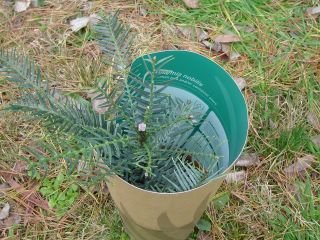
Here it is! A fair dinkum baby version of a living fossil all ready for planting!

Our group standsshivering ready for the planting in the Western Sydney Institute (TAFE) garden. (Hey, it's not like you weren't warned it would be cold, by crikey!!!)

Andy gives Mr. K a Certificate of Authenticity for the Wollemi Pine we are about to plant. His assistant, Colin, looks on.
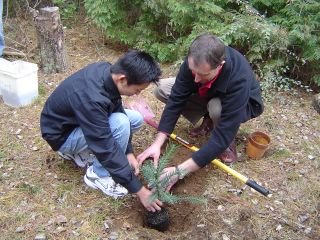
"David" is volunteered for the job. Such touching international cooperation!
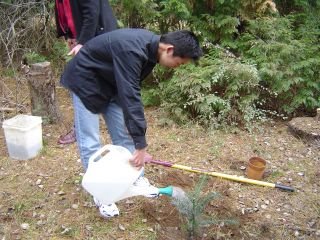
And finally the first watering. Well done, David!
After that, Colin places a commemorative plaque explaining that the tree was planted by students and faculty of our school on today's date. We have made history, and each of us is given a personalized copy of a certificate describing and authenticating the event. Well, not all of us are. My name is strangely missing in the pile.
"Sorry," says Andy. "We saw the Western name and assumed you were a guide or something. We didn't make you one."
No problem. Being discriminated against yet again for being a white, Anglo-Celtic, native English speaker doesn't bother me at all! I'm not bitter! No, really, I'm not!
Back on the bus again, we head to our next stop in the BLUE Mountains, which is a...movie theater??!?
Actually, it is a panoramic theater. It does show regular movies, but its main attraction is, well, panoramic movies...the kind that screw up your sense of balance so you either fall over, get seasick, or both. In our case, we are there to watch a special feature documenting the discovery of the Wollemi Pine. It's a special showing which is in Korean (which explains why we're inundated with Korean-speaking tour groups!), but we are given headsets that provide a Japanese translation.
Our tour guide looks at me, remembers with dismay the fact of my gaijin-ness, and also recalls that she has forgotten to ask for an English set for me. (Damned package tours!) We go to the front counter to remedy the situation, and the rather coldbitch young lady at the counter says dismissively, "There's no chance of my preparing another set, no." Fine. I make do with the Japanese translation. I've just been discriminated against because I speak the local language, but I'm not bitter. No, not at all.
Halfway through the movie the film hangs and melts. We're left sitting in the dark for about fifteen minutes before they get the thing going again. During that time there's a lot of muttering and yelling in Korean going on all around me. Actually, I'm feeling a sense of poetic justice, though I have to admit that the movie is interesting.
After that we have a buffet-style lunch in the cafeteria there in the theater. A lot of the Koreans are drinking, so they're getting a bit noisy. As for me, I get chatted up by our bus driver, who turns out to be a very friendly bloke. We're both wishing we could join the Koreans. After all, the place has XXXX Gold on tap (but no Foster's Lager). Nope. We're both working.
Now it's time for the biggest event: the BLUE Mountains bushwalk. We go up to the park that is the trailhead for the famous Katoomba Falls hike. There we are met by our ranger guide, who is a very interesting (and very vocal) woman with blond dreadlocks.
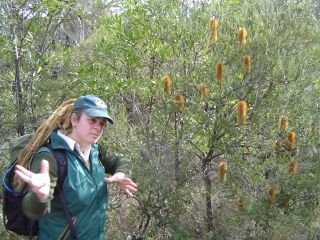
(Those things you see in the tree are like pine cones, only different.) When we start the bushwalk, it is pretty flat and easy. Our ranger guide focuses mainly on the plant and animal life to be found in the area. Then we come to the very edge of the cliff, and the view starts to get interesting...
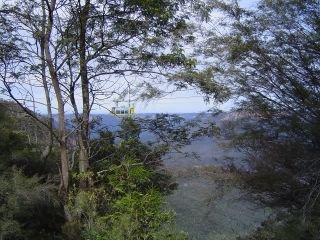
Here you can see the tramway that goes across the canyon...which we will not be taking...
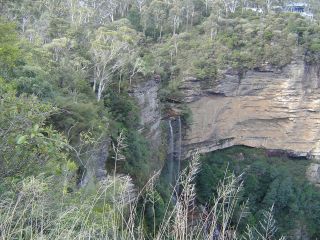
From the viewpoint at the very lip of the canyon, this is the view to the left. It is Katoomba Falls, which are very low this year thanks to the drought that is gripping most of the country.

This is the view to the right. Believe it or not, this is only one of five sections of the BLUE Mountains.
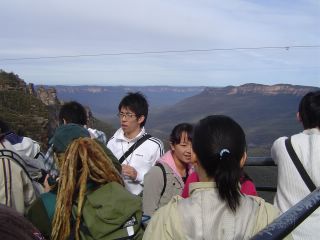
And right in the middle you can see the famous Three Sisters rock formation...if you look past our astonished-looking group.
Okay...now I will tell you why they are called the BLUE Mountains. The overwhelming majority of the trees you see down in the canyons are gum trees (i.e. eucalyptus). Gum trees actually shed eucalyptus oil into the surrounding air, and it forms a layer of very thin mist close to the ground. This mist reflects blue light, giving the mountains in the distance a ghostly, bluish quality (that isn't so clear in these photos, unfortunately).
Once we're done at the viewpoint, we start our descent...down a narrow, twisting path and a great many staircases that eventually level out on what seems like the bottom but is really a ledge about halfway down. (We never do make it all the way to the bottom even after going down over a thousand steps. Yes, a couple of our students did count them...rather noisily...all the way along.)

This is what it looks like down in the canyon even though we're not all the way down. Hold me closer, Ed; i-it's gettin' dark...

Here's a view of the Three Sisters. Actually, the three local Aborigine tribes call them the "Seven Sisters". No one knows why, but it has been theorized that either they include face-like features in the surrounding rock or there used to be additional pillars which have collapsed over time.
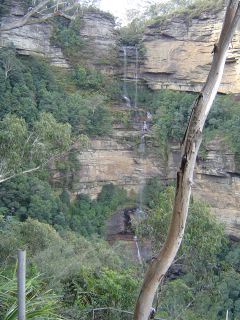
Here's a better view of Katoomba Falls. Unfortunately, you can't really make out the flock of wild cockatoos in the trees on the bottom left side of the picture...
(To be fair, I have only included pictures which I took myself. Both Ms. Y and Mr. I had some really good ones from inside the canyon, and they gave me copies, but I don't want to have to bother with credits and all that.)(Actually, I left them at the school, and I'm too impatient to wait until I can go and get them...)
The trail continues to wind and go down narrow, steep staircases. We find places where patches of clay of different colors emerge from the cliff face, and our guide explains that the Aborigines used them as face and body paint. (Just for good measure, she puts some white stripes on her face.) Further down the path actually goes back under the cliff face in places where water has eroded out soft layers of sandstone. The Aborigines apparently used such places as temporary lodgings in their nomadic wanderings through their respective territories.
Along the way we keep hearing really loud and obnoxious-sounding squawking, obviously from some kind of bird. When the trees clear we see the source: a large flock of some kind of white bird. Then one of them lights in a nearby tree and cheekily puffs out the bright yellow crest on its head. I'd always heard there were wild cockatoos in Australia, but this is the first time for me to see them first hand. Accustomed as I am to seeing them in cages, it's a bizarre experience...
Eventually we come to the obvious end of the hike, though we're still not yet to the bottom. We are at the entrances of the old mines, the reason the trails down the cliff face were made in the first place about a hundred years before. The main entrance is big enough to walk through. The others are flooded crawlways with rusted rail tracks coming out. We appear to have found civilization. It is crowded here, and we soon find out why. We are given a choice. We can either take more stairs going back up a ways and then take the tram back or we can ride right back up the cliff face using what is billed as the steepest railway in the world. We decide on the latter.
Railway, my foot! When it moves (with us sitting backward), it goes straight for only a very short distance before shooting upward at a 52 degree angle, the last part of which is through a very low and narrow tunnel. They warned us about losing our belongings (which is why my camera stayed buttoned in my coat pocket), but for a while I was seriously worried I was going to topple out! Fortunately, we arrive safely at the station at the top.
We disembark from the train, our guide checks in at the gate counter, and then she leads us through the group exit. I'm almost right behind her, but just as I'm passing through, the woman at the counter suddenly yells angrily, "Hey, you!! Excuse me!! Where is your ticket?!?" Trying not to sigh too loudly, I reply, "I'm a member of this school group." Probably after noting the Yank accent, the woman lets me pass, but the wary gaze under deeply furrowed brows tells me she's not convinced.
(Note for future reference: next time a group from Ye Olde Academy comes to Sydney, consider cosmetic surgery to look Japanese and use of a Japanese alias in order to lessen the discrimination...)
We come out of the 19th-century mining installation (or what's made to look like one) and emerge into the parking lot of a very impressive, modern-looking facility including a museum, conference and exhibit halls, and a bus station. Near the main entrance is a very eye-catching work of art consisting of life-size, (and quite life-like,) black-painted bronze statues of six Aborigines, specifically four women and two men, engaged in a lively dance. All six are stark naked. A group of very amused Korean tourists are taking turns having their pictures taken standing next to the statues, guffawing loudly as they do so. Nearby, a trio of Indochinese-looking women in hajib and abayah are sitting quietly on a bench surveying the scene with looks of bewilderment on their faces. Finally, when the Koreans start grabbing certain parts of the statues' quite correct anatomies and making silly noises, the three Muslim women quietly stand up and hurry away.
Talk about culture clash...
We get back on the bus, and since we are a little ahead of schedule (and our bus driver manages to skirt the worst of the traffic), we pop into the Sydney Olympic Park, the scaled-down remnant of the Sydney Olympic venue. It's quite impressive and very well thought out. The structures were built from the start with permanent and temporary sections, so rescaling them was a cinch. The various buildings are not only interconnected in various ways, but there is a looped underground tram system circling under the whole area, with multiple access tunnels from each arena. It is said that, during the Sydney Olympics, they could clear out an entire stadium, with a capacity of many thousands, in only about ten minutes. This forms an enormous (and, when you think about it, humiliating) contrast with the disastrous Atlanta Olympics, in which all transportation was by hired local buses, and traffic before and after each event often wound up snarled for over an hour. Perhaps I should add that all of the lights in the Olympic Park are independently solar powered.

Oh, come on! Not another group shot! It's bloody freezing!!!
Finally, we go down to the famous waterfront at Darling Harbour, where we have our last meal in Australia.

Darling Harbour. Will you guys hold still?!?

The convention centre and the restaurant where we have dinner. Only Mr. K isn't blurry in this long-exposure shot. Go figure...
While we're waiting for our reservation, I walk around the waterfront wildly fumbling with my camera's flash and exposure settings and snapping pictures (most of which wind up either too dark or blurry). Then I go into the mall, where I find a shop of Aborigine crafts. I go in there and chat for a while with the shopkeeper, who is apparently half Aborigine. He says he's happy for the company; it's off-season, and he's bored. A couple of students, obviously out looking for me, pop in and inform me that dinner is ready. I leave, but not before I grab a colorful (BLUE) boomerang I have been eyeballing. I tell him that, as a musician, I'd much rather get one of those cool-looking didgeridoos, but I know that getting it home would be a pain. The shopkeeper suggests I get one next time I come. I tell him that gives me another good reason to come back.
Dinner is good, but we're all feeling rather burned out...or maybe even bummed out. We know the dream is coming to an end.
Next thing we know we're at Sydney Airport checking in. All our luggage is heavier than before, and the check-in staff lectures us as they slap on a whole bunch of "heavy" tags. After that it's just the short-but-oh-so-long walk to the security gates. Things are feeling pretty dark.
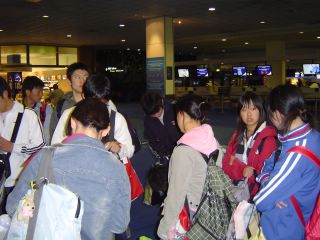
"Do we really have to leave now?"
We have a couple of hiccups at the security gate. We've forgotten that Australia is stricter than Japan, and a couple of students get nailed with banned items in their carry-on bags, leading to full examinations and friskings. No strip-searches or interrogations, though. The duty-free check-out desk goes much more smoothly. Soon we are at the gate. There aren't so many people there. It doesn't look like it's going to be a full flight.
Actually, I don't remember much about the flight itself except the two occasions I woke up and stumbled in the dark to the rest room. I don't even remember very well what we ate. What I do remember is getting off the plane in Narita out on the tarmac to board shuttle buses...and getting hit by that awful blast of hot, humid weather. It's summer in Japan. Yep...we've come home.
Tomorrow I have to drive four of the kids out to the music club summer training camp, which actually started today.
Here it is at last: the Final Morning (rather dead-sounding fanfare).
In fact, it is &%$#* 5:30 in the &#%$* morning. That's when the #%$&* wake-up call rings. That's to give us enough time to throw our luggage together, have a nice (%#$&*) early breakfast, haul all our (%$&#*) gear down to the bus, and head off to the last chapter of our Australia adventure.
We have been warned that it is going to be cold. Sydney itself has been a bit on the chilly side, but now we are heading for the BLUE Mountains. At this time of year it's not uncommon for it to get down close to freezing up there. Yes, we have been warned of this fact repeatedly. That's why most of our kids are in light coats and more than one is wearing shorts. (Death before non-fashion, right?)
The drive up to the BLUE Mountains is nice and scenic. The urbanness of Sydney gradually gives way to lovely harbor towns and then becomes something more like those sleepy villages one finds around the Coast Mountains in Oregon. However, the BLUE Mountains are a very different animal from that. For one thing, they aren't really mountains at all. Rather, it is a great network of canyons carved into a high plateau. Millennia of erosion (and DON'T try to tell me it was only 6,000 years!) has given rise to wide, winding valleys and gorges filled with flat-topped monoliths that remind me of Zion Canyon in Utah, only much, much bigger and much, much greener. In fact, it's large enough that it's actually divided into five separate national parks.
So...why is it called the BLUE Mountains? I'm glad you asked, but you'll have to wait. I'll tell you later. (hehehehehe)
Our first stop is the Wentworth Falls campus of the Western Sydney Institute - Blue Mountains College, which is part of the TAFE (Technical And Further Education) NSW program. (The building is bigger than it looks in the photo.) It's essentially a technical and vocational college offering courses in a wide range of subjects, from IT to aromatherapy. It is also a major center for research and management of the BLUE Mountains. Anyway, we have come here for an informative lecture. No, it's not as boring as you no doubt think. Actually, it is quite interesting.
Our lecturer is a (very tall) bloke named Andy. He explains why the BLUE Mountains were named a World Heritage Site by the U.N. just a few years ago. A lot of it has to do with the fact that the many valleys and canyons that make up the BLUE Mountains are protected wilderness areas that are home to a great many species of plant and animal life, most of which are unique to Australia, many of which are unique to the area. The lecture includes not only pictures, but a lot of actual hands-on study of the many different varieties of tree (most of them various types of eucalyptus, but only two of which are edible by koala) and fern.
But that's not all.
You see, back in the mid '90s a group of researchers happened upon a very surprising stand of trees in an isolated ravine. It turned out that they were a very primitive variety of pine. In fact, not only were they a living fossil, but they were one experts claim dates from the time Australia was still attached to Africa. We're talking tens of millions (no, NOT 6,000) of years old! This is the so-called Wollemi Pine. There are only about a hundred of them left in the wild, but now it is apparently now available (in limited numbers) for commercial planting.
In fact, to commemorate our visit, the college has purchased a Wollemi Pine seedling, which one of our students is then asked to plant.

Here it is! A fair dinkum baby version of a living fossil all ready for planting!

Our group stands

Andy gives Mr. K a Certificate of Authenticity for the Wollemi Pine we are about to plant. His assistant, Colin, looks on.

"David" is volunteered for the job. Such touching international cooperation!

And finally the first watering. Well done, David!
After that, Colin places a commemorative plaque explaining that the tree was planted by students and faculty of our school on today's date. We have made history, and each of us is given a personalized copy of a certificate describing and authenticating the event. Well, not all of us are. My name is strangely missing in the pile.
"Sorry," says Andy. "We saw the Western name and assumed you were a guide or something. We didn't make you one."
No problem. Being discriminated against yet again for being a white, Anglo-Celtic, native English speaker doesn't bother me at all! I'm not bitter! No, really, I'm not!
Back on the bus again, we head to our next stop in the BLUE Mountains, which is a...movie theater??!?
Actually, it is a panoramic theater. It does show regular movies, but its main attraction is, well, panoramic movies...the kind that screw up your sense of balance so you either fall over, get seasick, or both. In our case, we are there to watch a special feature documenting the discovery of the Wollemi Pine. It's a special showing which is in Korean (which explains why we're inundated with Korean-speaking tour groups!), but we are given headsets that provide a Japanese translation.
Our tour guide looks at me, remembers with dismay the fact of my gaijin-ness, and also recalls that she has forgotten to ask for an English set for me. (Damned package tours!) We go to the front counter to remedy the situation, and the rather cold
Halfway through the movie the film hangs and melts. We're left sitting in the dark for about fifteen minutes before they get the thing going again. During that time there's a lot of muttering and yelling in Korean going on all around me. Actually, I'm feeling a sense of poetic justice, though I have to admit that the movie is interesting.
After that we have a buffet-style lunch in the cafeteria there in the theater. A lot of the Koreans are drinking, so they're getting a bit noisy. As for me, I get chatted up by our bus driver, who turns out to be a very friendly bloke. We're both wishing we could join the Koreans. After all, the place has XXXX Gold on tap (but no Foster's Lager). Nope. We're both working.
Now it's time for the biggest event: the BLUE Mountains bushwalk. We go up to the park that is the trailhead for the famous Katoomba Falls hike. There we are met by our ranger guide, who is a very interesting (and very vocal) woman with blond dreadlocks.

(Those things you see in the tree are like pine cones, only different.) When we start the bushwalk, it is pretty flat and easy. Our ranger guide focuses mainly on the plant and animal life to be found in the area. Then we come to the very edge of the cliff, and the view starts to get interesting...

Here you can see the tramway that goes across the canyon...which we will not be taking...

From the viewpoint at the very lip of the canyon, this is the view to the left. It is Katoomba Falls, which are very low this year thanks to the drought that is gripping most of the country.

This is the view to the right. Believe it or not, this is only one of five sections of the BLUE Mountains.

And right in the middle you can see the famous Three Sisters rock formation...if you look past our astonished-looking group.
Okay...now I will tell you why they are called the BLUE Mountains. The overwhelming majority of the trees you see down in the canyons are gum trees (i.e. eucalyptus). Gum trees actually shed eucalyptus oil into the surrounding air, and it forms a layer of very thin mist close to the ground. This mist reflects blue light, giving the mountains in the distance a ghostly, bluish quality (that isn't so clear in these photos, unfortunately).
Once we're done at the viewpoint, we start our descent...down a narrow, twisting path and a great many staircases that eventually level out on what seems like the bottom but is really a ledge about halfway down. (We never do make it all the way to the bottom even after going down over a thousand steps. Yes, a couple of our students did count them...rather noisily...all the way along.)

This is what it looks like down in the canyon even though we're not all the way down. Hold me closer, Ed; i-it's gettin' dark...

Here's a view of the Three Sisters. Actually, the three local Aborigine tribes call them the "Seven Sisters". No one knows why, but it has been theorized that either they include face-like features in the surrounding rock or there used to be additional pillars which have collapsed over time.

Here's a better view of Katoomba Falls. Unfortunately, you can't really make out the flock of wild cockatoos in the trees on the bottom left side of the picture...
(To be fair, I have only included pictures which I took myself. Both Ms. Y and Mr. I had some really good ones from inside the canyon, and they gave me copies, but I don't want to have to bother with credits and all that.)(Actually, I left them at the school, and I'm too impatient to wait until I can go and get them...)
The trail continues to wind and go down narrow, steep staircases. We find places where patches of clay of different colors emerge from the cliff face, and our guide explains that the Aborigines used them as face and body paint. (Just for good measure, she puts some white stripes on her face.) Further down the path actually goes back under the cliff face in places where water has eroded out soft layers of sandstone. The Aborigines apparently used such places as temporary lodgings in their nomadic wanderings through their respective territories.
Along the way we keep hearing really loud and obnoxious-sounding squawking, obviously from some kind of bird. When the trees clear we see the source: a large flock of some kind of white bird. Then one of them lights in a nearby tree and cheekily puffs out the bright yellow crest on its head. I'd always heard there were wild cockatoos in Australia, but this is the first time for me to see them first hand. Accustomed as I am to seeing them in cages, it's a bizarre experience...
Eventually we come to the obvious end of the hike, though we're still not yet to the bottom. We are at the entrances of the old mines, the reason the trails down the cliff face were made in the first place about a hundred years before. The main entrance is big enough to walk through. The others are flooded crawlways with rusted rail tracks coming out. We appear to have found civilization. It is crowded here, and we soon find out why. We are given a choice. We can either take more stairs going back up a ways and then take the tram back or we can ride right back up the cliff face using what is billed as the steepest railway in the world. We decide on the latter.
Railway, my foot! When it moves (with us sitting backward), it goes straight for only a very short distance before shooting upward at a 52 degree angle, the last part of which is through a very low and narrow tunnel. They warned us about losing our belongings (which is why my camera stayed buttoned in my coat pocket), but for a while I was seriously worried I was going to topple out! Fortunately, we arrive safely at the station at the top.
We disembark from the train, our guide checks in at the gate counter, and then she leads us through the group exit. I'm almost right behind her, but just as I'm passing through, the woman at the counter suddenly yells angrily, "Hey, you!! Excuse me!! Where is your ticket?!?" Trying not to sigh too loudly, I reply, "I'm a member of this school group." Probably after noting the Yank accent, the woman lets me pass, but the wary gaze under deeply furrowed brows tells me she's not convinced.
(Note for future reference: next time a group from Ye Olde Academy comes to Sydney, consider cosmetic surgery to look Japanese and use of a Japanese alias in order to lessen the discrimination...)
We come out of the 19th-century mining installation (or what's made to look like one) and emerge into the parking lot of a very impressive, modern-looking facility including a museum, conference and exhibit halls, and a bus station. Near the main entrance is a very eye-catching work of art consisting of life-size, (and quite life-like,) black-painted bronze statues of six Aborigines, specifically four women and two men, engaged in a lively dance. All six are stark naked. A group of very amused Korean tourists are taking turns having their pictures taken standing next to the statues, guffawing loudly as they do so. Nearby, a trio of Indochinese-looking women in hajib and abayah are sitting quietly on a bench surveying the scene with looks of bewilderment on their faces. Finally, when the Koreans start grabbing certain parts of the statues' quite correct anatomies and making silly noises, the three Muslim women quietly stand up and hurry away.
Talk about culture clash...
We get back on the bus, and since we are a little ahead of schedule (and our bus driver manages to skirt the worst of the traffic), we pop into the Sydney Olympic Park, the scaled-down remnant of the Sydney Olympic venue. It's quite impressive and very well thought out. The structures were built from the start with permanent and temporary sections, so rescaling them was a cinch. The various buildings are not only interconnected in various ways, but there is a looped underground tram system circling under the whole area, with multiple access tunnels from each arena. It is said that, during the Sydney Olympics, they could clear out an entire stadium, with a capacity of many thousands, in only about ten minutes. This forms an enormous (and, when you think about it, humiliating) contrast with the disastrous Atlanta Olympics, in which all transportation was by hired local buses, and traffic before and after each event often wound up snarled for over an hour. Perhaps I should add that all of the lights in the Olympic Park are independently solar powered.

Oh, come on! Not another group shot! It's bloody freezing!!!
Finally, we go down to the famous waterfront at Darling Harbour, where we have our last meal in Australia.

Darling Harbour. Will you guys hold still?!?

The convention centre and the restaurant where we have dinner. Only Mr. K isn't blurry in this long-exposure shot. Go figure...
While we're waiting for our reservation, I walk around the waterfront wildly fumbling with my camera's flash and exposure settings and snapping pictures (most of which wind up either too dark or blurry). Then I go into the mall, where I find a shop of Aborigine crafts. I go in there and chat for a while with the shopkeeper, who is apparently half Aborigine. He says he's happy for the company; it's off-season, and he's bored. A couple of students, obviously out looking for me, pop in and inform me that dinner is ready. I leave, but not before I grab a colorful (BLUE) boomerang I have been eyeballing. I tell him that, as a musician, I'd much rather get one of those cool-looking didgeridoos, but I know that getting it home would be a pain. The shopkeeper suggests I get one next time I come. I tell him that gives me another good reason to come back.
Dinner is good, but we're all feeling rather burned out...or maybe even bummed out. We know the dream is coming to an end.
Next thing we know we're at Sydney Airport checking in. All our luggage is heavier than before, and the check-in staff lectures us as they slap on a whole bunch of "heavy" tags. After that it's just the short-but-oh-so-long walk to the security gates. Things are feeling pretty dark.

"Do we really have to leave now?"
We have a couple of hiccups at the security gate. We've forgotten that Australia is stricter than Japan, and a couple of students get nailed with banned items in their carry-on bags, leading to full examinations and friskings. No strip-searches or interrogations, though. The duty-free check-out desk goes much more smoothly. Soon we are at the gate. There aren't so many people there. It doesn't look like it's going to be a full flight.
Actually, I don't remember much about the flight itself except the two occasions I woke up and stumbled in the dark to the rest room. I don't even remember very well what we ate. What I do remember is getting off the plane in Narita out on the tarmac to board shuttle buses...and getting hit by that awful blast of hot, humid weather. It's summer in Japan. Yep...we've come home.
Tomorrow I have to drive four of the kids out to the music club summer training camp, which actually started today.
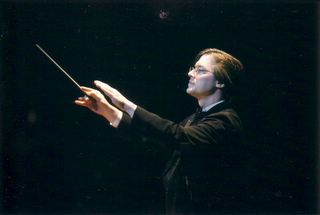


10 Comments:
Wow... what a packed last day! The Blue Mountains remind me of the Grand Canyon. Were your legs tired after hiking it? The pics are beautiful but like you say, pictures don't do the place justice. Same as the Grand Canyon.
Well, I would be a tad bit mad over being left out... especially in not getting a certificate of the tree planting. Odd that they didn't check... but like they said, they probably thought you were a tour guide or such. Funny that the lady screamed at you and thought you were trying to get thru w/out paying. Isn't it weird when you're on the other end of that type of behavior.
Japan's weather sounds like Bahrain. Very humid here as well. You walk outside and your sunglasses completely fog up and before you get to the car, you're soaked. fun!
The whole trip sounded great. Makes me want to see Australia. I hope to one day. Oh yeah... the wild birds sound fascinating. Would have loved to see those. What other types of animals lived in the mountains? Any koala's?
By Um Naief, at 3:15 AM
Um Naief, at 3:15 AM
I know those furrowed brows well...
"Excuse me, are you the Moody Minstrel? You are?" ktck ktck ktck ktck ktck ktck ktck ktck ktck ktck ktck clang.
Great pics! Great story too. Have you considered doing freelance writing on the side? I bet you could sell books just writing what you do for this blog. Its always an interesting and fun read!
By DewKid, at 6:13 AM
DewKid, at 6:13 AM
Awwwwww, you got rid of the dancing banana chat room. Guess I'll have to go elsewhere for my inane fun! :-)
By DewKid, at 6:14 AM
DewKid, at 6:14 AM
Wow! Your narration is so informative and so funny. You should send your story to Lonely Planet as a guide to Oz! Or a travel magazine.
You were invisible - the white guy? You should have spoken to them in Japanese and say, Me no speak Inglish. Confuse them.
The flock of cockatoos? Can't believe some kids only see them in cages. Awful.
I can picture the Muslim girls and those naturalistic statues. Hmmmm.
You need a good rest now.
W.
By Peceli and Wendy's Blog, at 6:37 AM
Peceli and Wendy's Blog, at 6:37 AM
"Australia is stricter than Japan"..that's just the wrong way round!
I would love to walk in a forest of eucalyptus trees breathing in the oils! I have a bottle of euc oil for when I get a cold.
It's stronger than Tea Tree oil, which funny enough is also from Oz. Awesome trees, those.
Oh, and that Wollemi Pine - bloody heck, if there's only 100 left, your planted one must have been expensive!
If I were you, with the tiredness and the GE reflux, and the discrimination, I'd probably end up struggling to keep dry eyes. (My landlady yelled at me by accident the other day and I wanted to cry for an hour after.)
Hey, just a wild guess, but...is your favourite colour, um, blue...? :P
By Olivia, at 7:27 AM
Olivia, at 7:27 AM
Tooners
Strangely enough, I wasn't satisfied after the hike. I wanted more!
I know the foggy glasses thing very well...basically every time I get out of my car.
There are LOTS of animals in the Blue Mountains. Mostly a whole lot of different kinds of birds, but, yes, there are koalas there. Lots of them. There are also wombats, wallabies, and other things.
Dewkid
I did NOT get rid of the chat room! In fact, I recently updated the code to extend my use of it! It still shows up when I access the site! Is it not working for you?
Wendy
Wow, thanks for the compliment!
I'd never seen a wild cockatoo till then. We don't have them in the U.S. or Japan. It was actually surprising.
The crazed Koreans getting off on fondling the statues and the three abayah-clad Muslim women quietly watching them with distaste provided such a funny contrast that I really wished I'd had a video camera with me at the time!
Olivia
The forest definitely had a fragrance very different from the ones in Oregon and Japan! Gum tree leaves can be very pungent; just pluck one and crumple it in your hand, and the smell will remain for a long time. Fortunately, it's a very good smell.
Tea tree? I like that smell!
I think I was too numb to cry by that point, though the reflux had long since quieted down. I was just feeling kind of burnt out.
My favorite color, blue? Probably...;-)
By The Moody Minstrel, at 4:48 PM
The Moody Minstrel, at 4:48 PM
Well, your exchanging students sure had a wonderful experience.
Actually, I stayed in Sydney 5 days more than 15 years ago and visited the Blue Mountains, the Three Sisters and Jenolan Cave...etc. Then after 5 years later, I stayed near Melbourne and tought Japanese culture and the language as an assistant teacher in a private primary school.
That was fun.
By Anonymous, at 6:24 PM
Anonymous, at 6:24 PM
Finally I have time to finish your post. You must be an interesting guy to talk to, Moody. I wonder when you will stop (talking). Or rather, how. Hehe. Just kidding ok...
Anyway thanks for another WHS. I hope the all BLUEs can make you forget about the certificate. And the English translation headsets. Or the ticket-incident. Cultural clash indeed :p
Enjoy your summer!
By @ロウ 。LOW@, at 9:36 PM
@ロウ 。LOW@, at 9:36 PM
Yeah, Minstrel, don't ever stop talking coz we don't want to stop reading.
By Olivia, at 7:54 AM
Olivia, at 7:54 AM
Early, early morning calls... caught in the 'wrong' cold weather... part of traveling 'pressure' eh?
By Lrong Lim, at 5:43 PM
Lrong Lim, at 5:43 PM
Post a Comment
<< Home